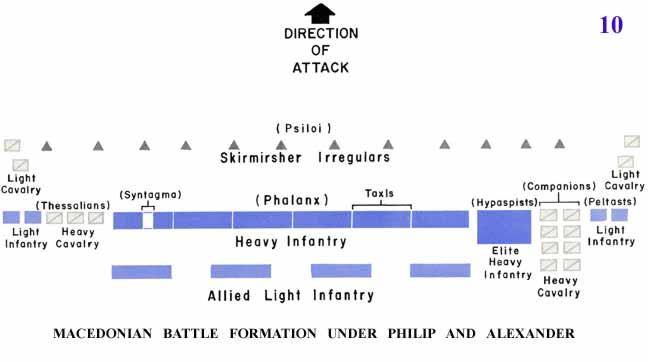Reorganization of the Macedonian Army
Philip provided his Macedonian solders in the phalanx with sarissa, a spear which was long 6 meters, about 18 feet. The sarissa, when held upright by the rear rows of the phalanx (there were usually eight rows), helped hide maneuvers behind the phalanx from the view of the enemy. When held horizontal by the front rows of the phalanx, it was a brutal weapon for people could be run through from 20 feet away. 
The Macedonian phalanx
Philip made the military a way of life for the Macedonian men. It became a professional occupation that paid well enough that the soldiers could afford to do it year-round, unlike in the past when the soldiering had only been a part-time job, something the men would do during the off peak times of farming. This allowed him to count on his man regularly, building unity and cohesion among his men.
----------------------------------------
General Strategy - Hints and Tips
Try to use Infantry to lure opponents in, then try to flank them with cavelry or elephants if available.When you have elephants try to use them against the enemy's cavelry then use your cavelry to circle around and hit from flanks and rear.When playing against the Romans try to send skirmishers or light infantry out around them thus usually getting a Legion or at least a good portion of one to go after them thereby opening gaps in their line allowing your troops to hit them on the flanks or rear.At every chance go after routed units with cavelry or infantry if necessary.
Attack slowly so that every other move you can recover cohesion with group recover cohesion commands, this is a big help in keeping your army from just disintegrating after just a few moves, even when faced with time limits.
Most importantly try to stay flexible enough to react to your opponents moves and any of your own that don't go as planed. In other words cover your back, your flanks and your options!
Try to keep your off-centre and wing commanders back to rally routed units and use the rest for attacks.
|

This is the standard battle formation used by Alexander and Phillip II
Adding captions makes my pictures more interesting.
Send an email |


